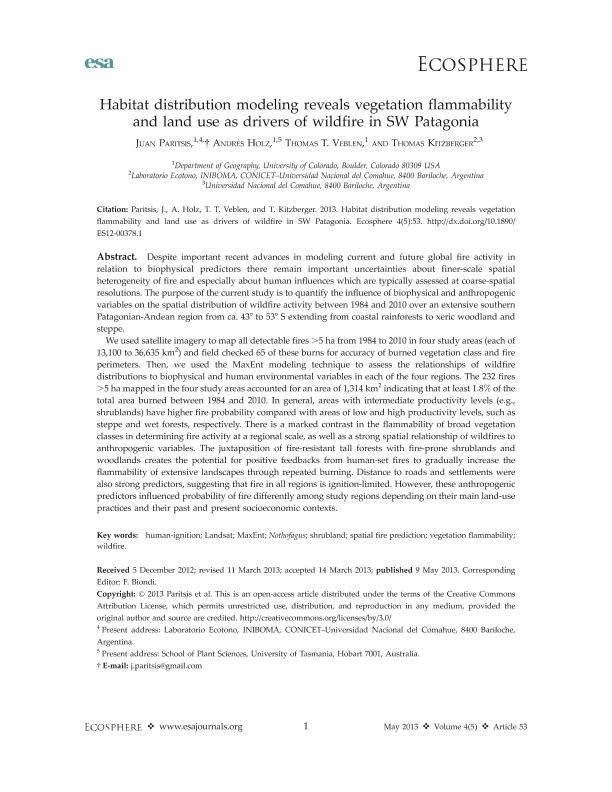Mostrar el registro sencillo del ítem
dc.contributor.author
Paritsis, Juan

dc.contributor.author
Holz, Andrés
dc.contributor.author
Veblen, Thomas T.
dc.contributor.author
Kitzberger, Thomas

dc.date.available
2016-07-27T20:52:53Z
dc.date.issued
2013-05
dc.identifier.citation
Paritsis, Juan; Holz, Andrés; Veblen, Thomas T.; Kitzberger, Thomas; Habitat distribution modeling reveals vegetation flammability and land use as drivers of wildfire in SW Patagonia; ESA; Ecosphere; 4; 5; 5-2013; 1-20
dc.identifier.issn
2150-8925
dc.identifier.uri
http://hdl.handle.net/11336/6746
dc.description.abstract
Despite important recent advances in modeling current and future global fire activity in relation to biophysical predictors there remain important uncertainties about finer-scale spatial heterogeneity of fire and especially about human influences which are typically assessed at coarse-spatial resolutions. The purpose of the current study is to quantify the influence of biophysical and anthropogenic variables on the spatial distribution of wildfire activity between 1984 and 2010 over an extensive southern Patagonian-Andean region from ca. 43° to 53° S extending from coastal rainforests to xeric woodland and steppe.
We used satellite imagery to map all detectable fires > 5 ha from 1984 to 2010 in four study areas (each of 13,100 to 36,635 km2) and field checked 65 of these burns for accuracy of burned vegetation class and fire perimeters. Then, we used the MaxEnt modeling technique to assess the relationships of wildfire distributions to biophysical and human environmental variables in each of the four regions. The 232 fires > 5 ha mapped in the four study areas accounted for an area of 1,314 km2 indicating that at least 1.8% of the total area burned between 1984 and 2010. In general, areas with intermediate productivity levels (e.g. shrublands) have higher fire probability compared with areas of low and high productivity levels, such as steppe and wet forests, respectively. There is a marked contrast in the flammability of broad vegetation classes in determining fire activity at a regional scale, as well as a strong spatial relationship of wildfires to anthropogenic variables. The juxtaposition of fire-resistant tall forests with fire-prone shrublands and woodlands creates the potential for positive feedbacks from human-set fires to gradually increase the flammability of extensive landscapes through repeated burning. Distance to roads and settlements were also strong predictors, suggesting that fire in all regions is ignition-limited. However, these anthropogenic predictors influenced probability of fire differently among study regions depending on their main land-use practices and their past and present socioeconomic contexts.
dc.format
application/pdf
dc.language.iso
eng
dc.publisher
ESA
dc.rights
info:eu-repo/semantics/openAccess
dc.rights.uri
https://creativecommons.org/licenses/by/2.5/ar/
dc.subject
Human-Ignition
dc.subject
Max-Ent
dc.subject
Nothofagus
dc.subject
Wildfire
dc.subject.classification
Ecología

dc.subject.classification
Ciencias Biológicas

dc.subject.classification
CIENCIAS NATURALES Y EXACTAS

dc.title
Habitat distribution modeling reveals vegetation flammability and land use as drivers of wildfire in SW Patagonia
dc.type
info:eu-repo/semantics/article
dc.type
info:ar-repo/semantics/artículo
dc.type
info:eu-repo/semantics/publishedVersion
dc.date.updated
2016-07-22T18:51:49Z
dc.journal.volume
4
dc.journal.number
5
dc.journal.pagination
1-20
dc.journal.pais
Estados Unidos

dc.description.fil
Fil: Paritsis, Juan. State University Of Colorado-boulder; Estados Unidos. Consejo Nacional de Investigaciones Científicas y Técnicas. Centro Científico Tecnológico Patagonia Norte. Instituto de Investigación en Biodiversidad y Medioambiente; Argentina
dc.description.fil
Fil: Holz, Andrés. State University Of Colorado-boulder; Estados Unidos
dc.description.fil
Fil: Veblen, Thomas T.. State University Of Colorado-boulder; Estados Unidos
dc.description.fil
Fil: Kitzberger, Thomas. Consejo Nacional de Investigaciones Científicas y Técnicas. Centro Científico Tecnológico Patagonia Norte. Instituto de Investigación en Biodiversidad y Medioambiente; Argentina
dc.journal.title
Ecosphere
dc.relation.alternativeid
info:eu-repo/semantics/altIdentifier/doi/http://dx.doi.org/10.1890/ES12-00378.1
dc.relation.alternativeid
info:eu-repo/semantics/altIdentifier/url/http://onlinelibrary.wiley.com/doi/10.1890/ES12-00378.1/abstract
dc.relation.alternativeid
info:eu-repo/semantics/altIdentifier/doi/10.1890/ES12-00378.1
Archivos asociados
